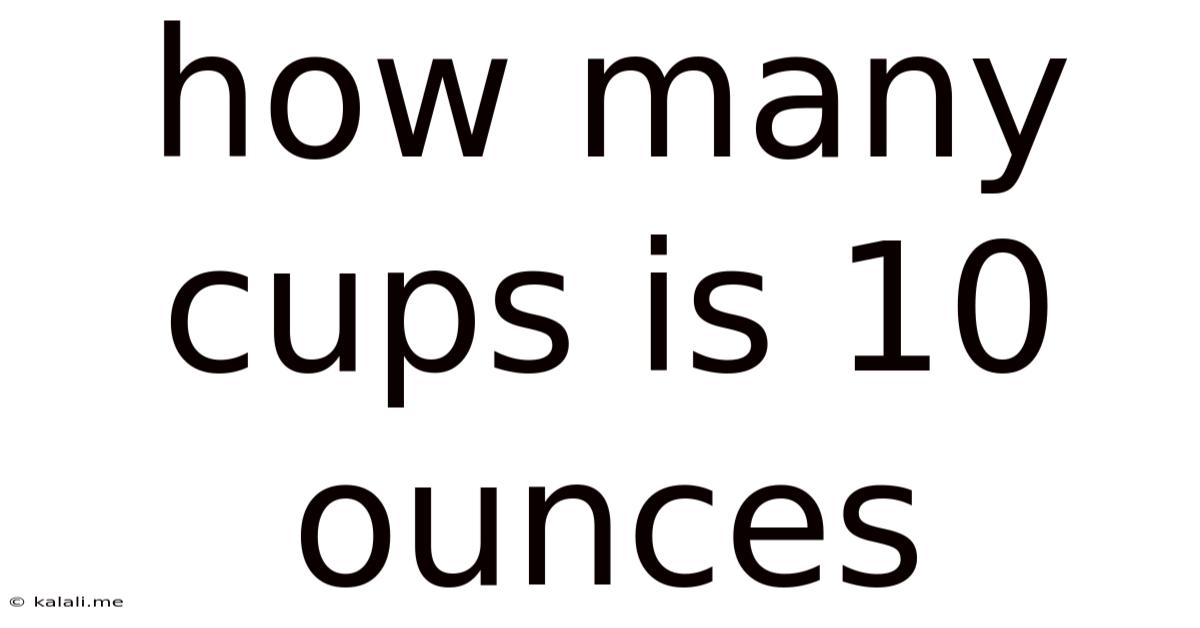How Many Cups Is 10 Ounces
Kalali
Mar 09, 2025 · 4 min read

Table of Contents
How Many Cups is 10 Ounces? A Comprehensive Guide to Volume Conversions
Understanding volume conversions, especially between cups and ounces, is crucial for anyone who enjoys baking, cooking, or simply following recipes accurately. While the conversion isn't always straightforward due to variations in cup sizes, this comprehensive guide will clarify exactly how many cups are in 10 ounces and provide you with the knowledge to confidently tackle future volume conversions.
Understanding the Units: Cups and Ounces
Before diving into the conversion, let's solidify our understanding of the units involved. Both cups and ounces are units of volume, but they are used in different contexts and have slightly different meanings.
Cups: A Household Measure
Cups are a common unit of volume in cooking and baking, primarily used in the United States and other countries using the US customary system. A standard US cup is defined as 8 fluid ounces. However, it's important to note that "cup" is not a precisely defined unit like a liter or a milliliter. Different types of cups may slightly vary in size. Therefore, it’s best to use standardized measuring cups for accurate results.
Ounces: Fluid vs. Weight
Ounces can refer to both weight (avoirdupois ounces) and volume (fluid ounces). It's vital to distinguish between these two when dealing with conversions. This article focuses on fluid ounces, which are a unit of volume commonly used in recipes and liquid measurements in the US customary system.
Converting 10 Fluid Ounces to Cups: The Calculation
The core question: how many cups is 10 ounces? The answer is straightforward when considering a standard US cup.
Since 1 US cup equals 8 fluid ounces, we can use a simple proportion to perform the conversion:
- 1 cup / 8 ounces = x cups / 10 ounces
Solving for 'x', we multiply both sides of the equation by 10 ounces:
- x cups = (1 cup / 8 ounces) * 10 ounces
This simplifies to:
- x cups = 1.25 cups
Therefore, 10 fluid ounces is equal to 1.25 cups.
Practical Applications and Considerations
Understanding this conversion has many practical applications.
Baking and Cooking
Accurate measurements are paramount in baking, as even slight variations can significantly impact the outcome. Knowing that 10 ounces is 1.25 cups ensures precision when following recipes that specify volume in ounces. This is particularly relevant for recipes that list ingredients like liquid extracts, oils, or juices.
Recipe Conversions
Many recipes, particularly older ones or those originating from different regions, may list ingredients in ounces instead of cups. This conversion skill empowers you to easily adapt such recipes to your needs. Knowing how to convert fluid ounces to cups allows for seamless transitions between different measurement systems.
Scientific and Medical Applications
While less common than in cooking, volume conversions are used in scientific experiments and medical contexts. Understanding the relationship between cups and ounces contributes to accurate data collection and experimentation.
Beyond the Basic Conversion: Addressing Variations
While 1.25 cups is the standard conversion for 10 fluid ounces, it's important to account for potential variations.
Different Cup Sizes
While most standardized measuring cups adhere to the 8-ounce standard, some cups might be slightly larger or smaller. Always use the measuring cups specified in your recipe. In the case of significant variance, the converted value may not be entirely accurate.
Metric System Equivalents
For those accustomed to the metric system, it is beneficial to understand the metric equivalents. 10 fluid ounces is approximately equal to 295.7 milliliters. This information is invaluable if you are converting recipes or working with measurements from a metric source.
Fractional Conversions
The result of 1.25 cups can be expressed as 1 ¼ cups. In certain recipes, using the fractional representation may be more convenient for accurate measurement using standard measuring cups.
Advanced Tips and Tricks for Accurate Conversions
For consistently accurate conversions, consider these additional tips.
- Use Standardized Measuring Cups: Invest in a good quality set of standardized measuring cups for consistent measurements. Avoid using improvised cups or mugs.
- Utilize Online Conversion Tools: Numerous online tools facilitate accurate conversions between cups and ounces. These tools often account for variations in cup sizes.
- Understand Liquid vs. Dry Measurements: Remember that the conversion applies specifically to fluid ounces. Dry ingredients, such as flour or sugar, measured in ounces, may not convert to cups in precisely the same manner due to variations in density and packing.
- Double Check Your Calculations: It's always wise to double-check your conversions to avoid errors, particularly in baking where precision is critical.
Conclusion: Mastering Volume Conversions for Success
Mastering the conversion from ounces to cups is a valuable skill for anyone working with recipes or engaging in activities requiring accurate volume measurements. While the fundamental conversion is straightforward – 10 fluid ounces equals 1.25 cups – understanding the potential variations and utilizing accurate measuring tools ensures consistently successful results. This understanding empowers you to confidently adapt recipes and accurately measure ingredients, leading to better outcomes in cooking, baking, and various other applications. By following the guidelines outlined in this comprehensive guide, you will confidently navigate the world of volume conversions and achieve greater accuracy in your endeavors.
Latest Posts
Latest Posts
-
How Far Is 0 4 Miles To Walk
Jul 12, 2025
-
What Is 20 Percent Of 800 000
Jul 12, 2025
-
Words That Start With Y In Science
Jul 12, 2025
-
Prevent An Expressway Emergency By Merging Without
Jul 12, 2025
-
How Many Grams Of Sugar In A Pound
Jul 12, 2025
Related Post
Thank you for visiting our website which covers about How Many Cups Is 10 Ounces . We hope the information provided has been useful to you. Feel free to contact us if you have any questions or need further assistance. See you next time and don't miss to bookmark.